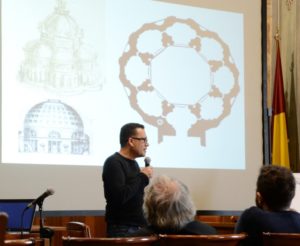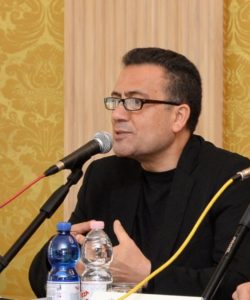What will you engage in?
What future will you invent?
he invention of the future
Issues raised through the use of question pronouns “what, when, who…”, especially if posed to provide individual answers to behaviours shared within a community, always make me uncomfortable, because they presuppose answers that interlocutors often don’t provide in a thought-out manner.
However, evolution, the anthropisation of the planet and, more in general, the dialogue between human beings are built on an alternating between question and answer, as the history of philosophy teaches us. Two modalities that take turns to bring order to creation, as conveyed by Michelangelo Pistoletto’s sign of the Third Paradise, as well as by his Mirror Paintings.
If the gathering in which the dawning humanity posed itself the first question saw the participation of Adam, Eve and the Snake, which offered the first responses to the interrogation, the bite of the apple was “the first resolved answer” given to meet the rising needs of humankind. An answer that determined the shift from the First to the Second Paradise. Questions build the future and the bite of the apple inaugurated a future that would see mankind evolve towards the art of forging artifice, this way simulating an almost divine creative power. We can therefore trace back the origin of the invention of the future and of the Second Paradise to this particular moment in mythological history, which was followed by the expulsion from the Garden of Eden.

Questions imply a change of direction, an alternative to the present situation. New questions are the reflection of renewed needs and finding the answers produces new projects, objects and behaviours.
In this great creative ability hidden in questions we also find the reason for the uneasiness they generate. It becomes therefore clear that we need to avoid impulsive and selfish answers, which merely outline populist and unfair futures.
In other words, planning the future relying on the answers of who is about to resolve a problematic issue without expressing a rational, mindful and balanced thought is the first risk of a not-so-simple endeavour. The invention of the future is the most complex task collectivity has had to face along the path of its evolution. The visions of the single individuals must meet and interact with those of millions of other scenarios painted observing the world from different points of perspective.
All of their elaborations, with which the new roles of people are identified, entail a detachment between the present I and a future I projected into a temporal scenario yet to come.
The failure of the attempt to mediate between the different individual perspectives opens the space up to conflict and clash, and leads to a guerilla war meant to defeat the enemy, i.e. who has planned a future different from ours.
The responsibility to fill the void between the present and an imagined future belongs to the philosophical and scientific theories, as well as to the research on the sense of divine. Refined conceptual tools are assigned the task to project the perspective of feasible future ideals along the line of unprecedented events yet to be planned and built. A long-term objective then, whose achievement involves different generations, encouraged to proceed towards a horizon that moves further away from us every time we try to reach it, forcing our contemporaries to continuously adapt their visionary perspectives.

The nearer we get to the planned future, which thus becomes the present, and the more the distance of our ideal horizons remains fixed, the further our imagination travels, and with it its philosophical, scientific and religious elaborations. A process of construction that develops in time and reflects the evolution of Michelangelo Pistoletto’s individual and then collective speculation, which has unfolded from the mirror through the Third Paradise to the Reintegrated Apple.
“What, when, who…”, question pronouns fostering a fleeting future, which slips away after a gesture has been made, like a smile the mirror has managed to register for an infinitesimal fraction of time. A split second that makes us realise that the Third Paradise, a balanced combination of past and future, is already present. The Third Paradise is present. We understand that it is here and now that we have to practise the future. The more we keep the future separate from our present “doing”, the more the future becomes a void too big to fill and stops belonging to us. This deduction allows us to face the transformation in progress with a clear mind, to become aware of the possibility each of us has to contribute to improving our present and the one of others, and this way to interact with a future that burns out and seems to be unreachable.
Participating in one’s own present consciously and actively is also the best remedy against the pessimism towards the future.
As far as I am concerned, as a rule to orient myself in the present “doing”, I have adopted, together with the principles of the Third Paradise, the 17 Sustainable Development Goals stated in the UN’s 2030 Agenda. Millions of people are already doing the same thing all over the world. I am convinced that sharing common objectives is a bit like playing in a jazz band: once you have identified the notes of the initial melody, the music is built and developed together, through variations on a theme produced by means of timbric languages, different instruments, and the freedom of each jazz player to express themselves needing to respect only the few constraints necessary to develop the composition. At the end of the performance, all the players will be conscious of having played good music created thanks to everybody’s contribution.
Fortunato D’Amico

